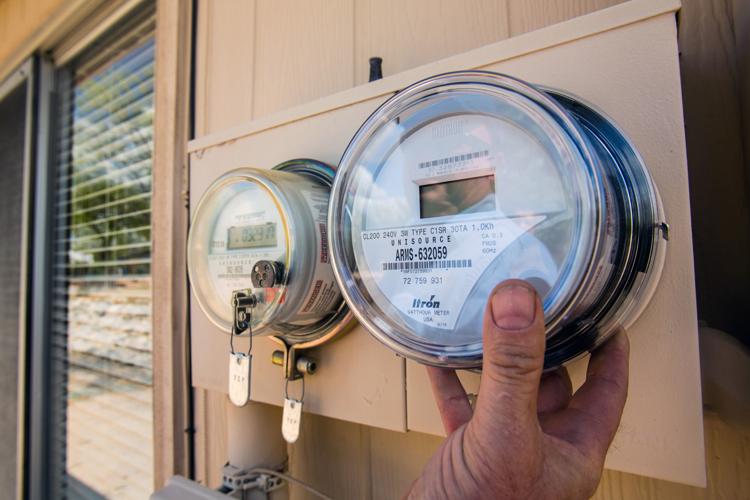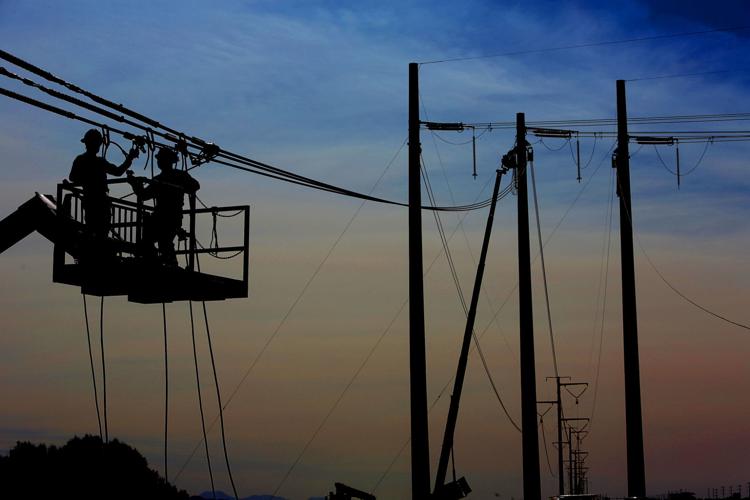A statewide moratorium on summertime power shut-offs adopted in June has helped more than 700 Tucson Electric Power customers keep their lights on and their air conditioners humming.
But those customers will have big bills to pay come mid-October when the disconnection ban ends and they must catch up on payment —something that worries advocates for low-income ratepayers.
In a recent filing with the Arizona Corporation Commission, TEP noted that 732 residential customers were eligible for disconnection in July, up 15% from 637 in July 2018.
TEP, which has about 420,000 customers overall, defines customers eligible for shut-off as those who fail to pay a delinquent bill of $300 or more by their termination date.
Meanwhile, past-due amounts are piling up.
The combination of more customers eligible for disconnection and higher past-due balances has pushed the average past due amount in July to $463, up 12% from July 2018.
And the total amount TEP was owed for past-due bills was about $340,000, up 41% from the same time last year.
The report detailed similar trends at UniSource Energy Services, a TEP sister utility that provides electric service to about 95,000 customers in Santa Cruz and Mohave counties.
The Corporation Commission adopted the summer moratorium on utility disconnects in mid-June, after it was reported that a Sun City West woman had died of heat-related causes in 2018 after Arizona Public Service Co. disconnected her service because she still owed $51 on her past-due bill.
On Friday, Corporation Commission staff proposed a permanent ban on electricity cut-offs for Arizona residents on the hottest, and the coldest, days of the year.
TEP spokesman Joe Barrios said the company recognizes that customers who were saved from disconnection under the moratorium could face huge bills come October, an issue utilities and consumer advocates raised as the Corporation Commission adopted the shut-off ban.
“Don’t let it get out of hand”
“It’s always a concern when customers reach out to us and say, ‘I’m in financial trouble’ or ‘I’m having trouble paying my bill.’ We just want to be sensitive to whatever circumstances they’re in,” Barrios said.
TEP has long offered customers payment extensions, including automatic short-term extensions online or by phone.
Now, the utility is actively reaching out to affected customers with letters encouraging them to pay what they can now to avoid insurmountable bills in October, and outlining payment options and referrals to financial aid.
“That’s basically the message — don’t let it get out of hand, don’t let it get away from you,” Barrios said. “If you can make partial payments, please do that. If you’re not sure how much flexibility you have or what your options are, call us and let us know where you’re at and what you’re capable of.”
When the ban is lifted Oct. 15, customers who would have had their power shut off if not for the ban will have to pay their outstanding balances, plus a reconnect fee, or arrange payments over four months, under the emergency rule adopted by regulators.
Barrios said the company has added customer-service workers to help answer questions about shut-offs and arrange payment plans, and field workers who normally visit delinquent customers to serve shut-off notices are explaining those options and leaving packets of information.
TEP has been meeting to discuss the shut-off ban and its potential impacts with officials of local nonprofit agencies, including the Pima County Community Action Agency, Interfaith Community Services and the Salvation Army, that handle local benefits from the federally funded Low Income Home Energy Assistance Program program, or LIHEAP.
Phoenix-based Wildfire, formerly known as the Arizona Community Action Association, and the Arizona Public Interest Research Group Education Fund also have advocated for consumers during proceedings on the summertime shut-off ban.
While many factors can contribute to an increase in the number of customers eligible for disconnection and past-due amounts, the double-digit increases in TEP’s recent report “should give commissioners pause on their policy,” said Diane Brown, executive director of Arizona PIRG.
“The concerns that consumer advocates raised on the Commission’s disconnection policy remain,” she wrote in an email.
“If a ratepayer is behind on their summer bills, which tend to be higher than the rest of the year, some consumers will almost certainly be faced with bills near impossible to repay in the allotted four-month period.”
More clients seeking help
The Salvation Army, which normally handles about four to eight utility assistance appointments a week, is seeing more clients and much higher past-due bill amounts than normal, said Nicole Cruz, case manager for the agency.
“A lot of people have the wrong idea about this,” Cruz said.
“You have a lot of people who are like, ‘Wow, I’ve got time to do this,’ but what they’ve forgotten is, you’re not getting free electricity for a month, it’s just being delayed and then come October, you’re going to have $2,000, $2,500 bills.”
LIHEAP assistance is limited to a maximum payment of $1,140, she said.
The Salvation Army also provides payment assistance, for TEP customers only, through the Help with Emergency Energy Relief Operation, or HEERO, which allows TEP customers to donate funds to help low-income customers by adding donations to payments on their own power bills.
Consumers seeking utility help are a mix of people who are unemployed with no regular income, folks on fixed disability or Social Security benefits and working people who can’t afford to pay their bills.
“A lot of them are working, they’re just not making enough money — they’re making minimum wage, $11 an hour and they’re feeding four or five kids in the house,” Cruz said.
Tim Kromer, chief program officer for Interfaith Community Services, says calls to the agency for utility assistance have dropped slightly, perhaps because people know they won’t be shut off for nonpayment any time soon.
“Much as other organizations are concerned, we’re concerned that in October we will see a dramatic increase in folks needing help, with bills higher than the grants we use will allow,” Kromer said.
“The message we’re giving is, you might not get shut off but you need to continue to pay your bill,” he said.
Evictions, homelessness are concerns
Some people who pay rent and utilities together face eviction if they can’t pay their utilities, said Manira Cervantes, Pima County Community Action manager.
“People don’t realize the need for utility assistance and the fact that people can become homeless if they can’t pay a utility bill,” she said, adding that the agency fields some 3,000 calls for aid help each month.
Cervantes said many clients of the county program are used to managing their bills by “robbing Peter to pay Paul” and may be using the shut-off moratorium to catch up on other bills.
The head of Wildfire agreed. “They’re always on the edge, so when they get that opportunity, they catch up on other things,” Wildfire Executive Director Cynthia Zwick said.
“The concern we have is, they’ve already built up a balance, you add it to the next bill and they’re stuck.”
There’s no new money being allocated to utility-assistance programs, though LIHEAP funding increased slightly in the state fiscal year that ended June 30, Zwick said.
Arizona got $22 million in LIHEAP funding, and Pima County got $4 million of that total, she said, adding that next year’s funding level is not yet known.
Wildfire also is administering $200,000 in aid to low-income customers that TEP agreed to pay as part of its last rate case.
Zwick applauded TEP customers for donating to HEERO, which historically brings in about $150,000 a year from TEP customers.
She and Arizona PIRG’s Brown also gave TEP kudos for being responsive in working with community agencies.






